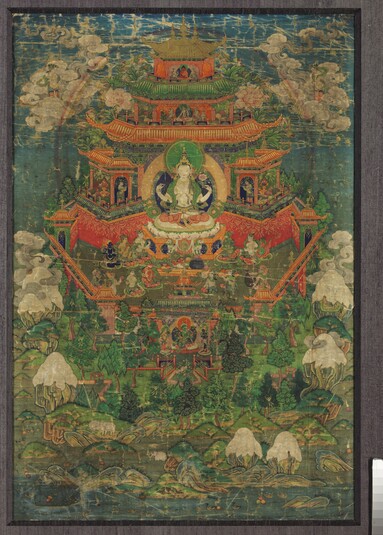
Item: Avalokiteshvara (Bodhisattva & Buddhist Deity) - Chaturbhuja (4 hands)
| Origin Location | Tibet |
|---|---|
| Date Range | 1700 - 1799 |
| Lineages | Buddhist |
| Material | Ground Mineral Pigment on Cotton |
| Collection | Private |
Alternate Names: Lokeshvara Avalokita Lokanata Lokanatha Mahakarunika
Classification: Deity
Appearance: Peaceful
Gender: Male
Avalokiteshvara and the Potalaka Pureland.
The Four-armed Lokeshvara (Chaturbhuja) is the most popular and most common form of Avalokiteshvara found in art. As a sub-group amongst those there is the context of the Potalaka Pureland with Lokeshvara seated at the center in front of the celestial palace. Often, Green Tara is located below the palace in the pureland of the Rosewood Forest - special for Tara.
Potalaka is an island believed to be located somewhere in the Indian ocean off the coast of Western India. In China, Potalaka is found as Puto Island just two hours south of Shanghai. Puto Island was visited in the past by Tibetan teachers such as Karma Pakshi and Zangpo Pal as early as the Yuan period. The Potala Palace in Lhasa, Tibet, traditional home of the Dalai Lama, is named after the Potalaka pureland.
Special Features of Potalaka:
- Island off the Coast of India (or China)
- Mountain
- Palace
- Avalokiteshvara
- Self-arising Lokeshvara in a rock
- Tara and the Rosewood Forest
Jeff Watt 7-2013
Buddhist Deity: Avalokiteshvara (Potalaka Pureland)
Collection: Christie's, July New Additions


